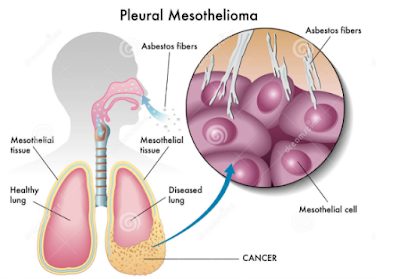 |
| Pleural Mesothelioma Cancer |
Pleural Mesothelioma Cancer | Prognosis, Symptoms & Diagnosis, Treatment
Pleural mesothelioma cancer is the mainly common of the four types of malignant mesothelioma cancer, accounting for about 75 percent of all cases of the disease. All four types share one similar trait. They are rare and aggressive forms of cancer. That means it is important to locate a diagnosis as soon as you sense something is wrong and if you do get a mesothelioma diagnosis, you should settle on treatment options as quickly as possible.Pleural mesothelioma cancer is a rare and malignant mesothelioma cancer caused by asbestos. Mesothelioma tumors form in the pleura, a thin membrane of cells that line the lungs and chest wall.
Pleural Mesothelioma Symptoms
The first pleural mesothelioma symptoms are typically included chest pain and shortness of breath. You may experience no symptoms at all in the first few stages of the cancer’s progression.The life expectation of someone with pleural mesothelioma is less than 18 months, but some patients live much longer. It often takes decades (20 to 50 years) for mesothelioma to develop after someone is first exposed to asbestos. This lag time called a latency period explains why the disease typically affects older people.
Presenting symptoms of pleural mesothelioma can be as ordinary as a chest pain, slight fatigue, or a shortness of breath during physical activity. Symptoms often mirror signs of less serious respiratory issues and are hardly strange for a senior.
Pleural mesothelioma cancer may take decades to develop after experience to asbestos, but it attacks quickly once taking hold. The microscopic asbestos fibers that are inhaled can lodge in the thin lining around the lungs and trigger physiological cellular changes that lead to this rare but aggressive cancer.
Many people with pleural mesothelioma are ignorant of their own condition for months or even years because initial symptoms are often mistaken for less intimidating illnesses. Any history of asbestos exposure, or even suspected asbestos exposure, should be discussed with a physician, who can refer a patient to a specialist right away. An early diagnosis is critical to survival because it can lead to more effectual therapy options.
Most symptoms of pleural mesothelioma involve the respiratory system and frequently are misdiagnosed because most medical professionals hardly ever see this disease. It's estimated that more than 2,000 people in the United States are diagnosed annually with this cancer. By comparison, an estimated 150,000 Americans are diagnosed with lung cancer each year.
Initial symptoms of pleural mesothelioma often are confused with pneumonia or asthma or another respiratory ailment. Even a specialist will need considerable time in adding to results of various, complex tests to provide a perfect diagnosis.
Pleural mesothelioma Stages
79 percent experienced shortness of breath64 percent suffered chest pain
36 percent had a chronic cough
90 percent obtainable with pleural effusions (excess fluid around lungs)
30 percent experienced significant weight loss
If any of these symptoms appear, and there is a history of asbestos experience, it is important to see a specialist.
Many patients diagnosed in stage I have no symptoms and the cancer is by chance detected through routine X-ray or other tests. In this early stage, the tumor burden is comparatively minimal and may not cause any noticeable symptoms. The two the majority common presenting symptoms of pleural mesothelioma are shortness of breath and chest pain. These symptoms typically develop as a result of pleural effusion or tumors pressing against the lung and chest wall, which can happen in stages I through III.
In stage II, as tumors spread beyond the pleural lung lining and into the lung and diaphragm, pain may increase and may be felt in the shoulder or upper abdomen in adding to the chest. Difficulty breathing and coughing may arise or inferior at this stage.
During stage III, tumors spread more carefully throughout the chest, placing pressure on the lungs and chest wall. These physical changes can lead to an increase in pain and difficulty breathing, dry cough, tightness in the chest, fatigue and weight loss.
By stage IV, tumors have spread throughout the chest and hardly ever spread to distant locations. The degree of tumor burden in the chest can harshly worsen pulmonary symptoms like shortness of breath. Others symptoms may include lumps of tissue under the skin on the chest, pain in the lower back, fever and night sweats. Some patients experience a hoarse voice and difficulty swallowing. At this stage, patients often need help breathing and require incessant oxygen.
Pleural Mesothelioma Diagnosis
The pleural mesothelioma diagnosis procedure for incorporates numerous tests and requires the close cooperation of a diverse team of medical experts. While the majority patients first meet with a general practitioner, their diagnosis can involve the expertise of radiologists, surgeons, oncologists, pathologists, pulmonologists and others.Pleural Mesothelioma Treatment
The treatment of pleural mesothelioma is constantly improving, increasing the probability of a improved prognosis for many people diagnosed with the disease. In addition to the standard treatment methods, a number of rising treatments currently in clinical trials are showing promising results.Although there is no cure for pleural mesothelioma, these treatment options enhance survival rates and improve quality of life.

No comments:
Post a Comment